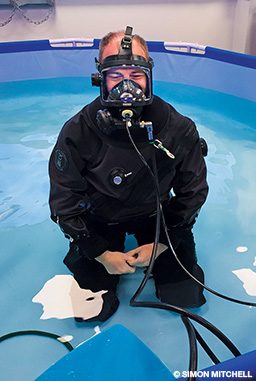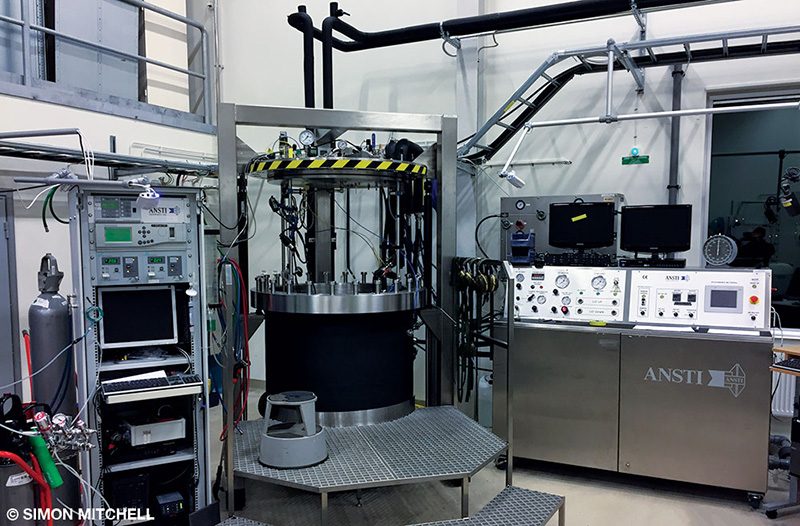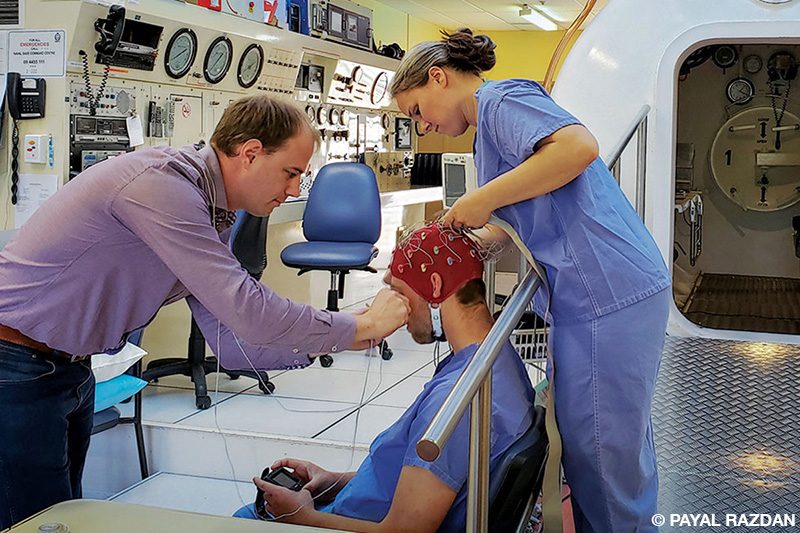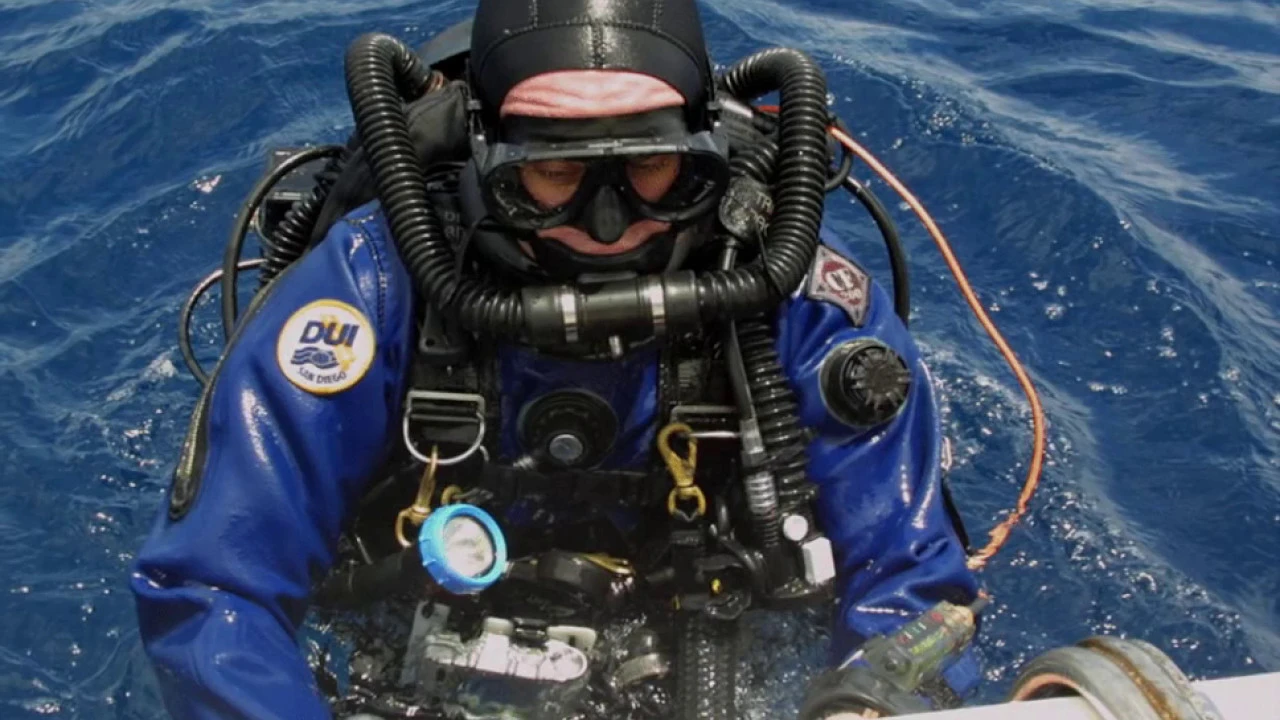Simon Mitchell mentors tomorrow’s leaders in dive research.
A recipient of multiple grants and awards in the fields of diving and dive medicine, Simon Mitchell, MBChB, Ph.D., is a professor and head of the Department of Anesthesiology at the University of Auckland. The former medical officer with the Royal New Zealand Navy has led several influential consensus workshops, is on the boards of numerous scientific journals and societies and was recently appointed editor of Diving and Hyperbaric Medicine. As a regular speaker at conferences, he is known for his passionate presentations sprinkled with artistic wreck photos. This avid rebreather diver does not need further introduction to the technical diving community. In short, everyone knows Professor Mitchell.
What is less known, however, is that he is mentoring several young scientists who conduct studies covering various aspects of diving and dive-related research. The current team of doctoral candidates and a postdoctoral fellow works in or closely with Mitchell’s laboratory in Auckland, New Zealand. Their work relates either directly or less obviously to the science of diving and may affect future dive operations.
Xavier Vrijdag, M.Sc.
Gas narcosis in hyperbaric environments

A DAN® instructor as well as a technical diving and freediving instructor, Vrijdag is an avid technical diver of caves and wrecks using open circuit and rebreathers. In his master’s thesis in technical medicine, he developed a quantitative electroencephalogram (qEEG) algorithm to quantify cerebral gas emboli in a swine model in a hyperbaric environment. This laid the groundwork for his current project: developing a novel qEEG algorithm to reliably assess the narcotic effects of inspired gases during diving and determining the relative effects of nitrogen, oxygen and carbon dioxide breathed at different pressures in real time.
To separate the effect of nitrogen, subjects performed their first deep air and heliox dives while being tested for mathematical speed and accuracy. These tests anchor the EEG data to the level of cognitive performance and link them to early signs of impairment. Professor Jamie Sleigh, a distinguished anesthesiologist and global expert on the effects of drugs on EEGs, is co-supervising the project.
“Xavier is currently looking for everything,” Mitchell says, “but the goal is to reduce the number of electrodes in this EEG, focusing only on the affected areas in the brain so that eventually a real-time monitor of narcosis might be feasible. This is not an easy task, and the ways brain regions communicate with one another or stop communicating because of narcosis are still not well understood.”
Denise Blake, M.D.
Early management of decompression sickness (DCS)
Supervised by Mitchell and Neal Pollock, Blake is a doctoral candidate at the James Cook University in Townsville, Australia. She is an emergency and dive medicine physician, combining these two areas in research about the prehospital management of DCS, focusing on oxygen delivery and retrieval considerations.
She has also published several articles comparing different mask types for oxygen delivery systems by measuring oxygen in the upper airway and tissue oxygen through the skin using transcutaneous oximetry levels. The efficiency of oxygen delivery systems is a major component in responding to DCS.
After identification of the optimum oxygen delivery device, participants will perform a “dive” in a hyperbaric chamber and then be placed on a vibrating platform, simulating a helicopter evacuation. Ultrasound examination of the heart will assess bubble production with and without previbration oxygen delivery. The evaluation of early management of oxygen administration and evacuation is highly relevant to DAN’s mission, and Blake’s work has had an impact on DAN training.

Chris Sames, M.D.
Epidemiology of occupational diving
Sames, director of the Hyperbaric Medical Unit in Auckland, focuses his research on aspects of occupational diving pathophysiology epidemiology in New Zealand. His centralized follow-up on hundreds of active occupational divers — including a full medical exam at entry and every five years along with an annual questionnaire about current health status — has led to a robust database of medical records and demographics over the past 25 years.
He uses this database to address questions such as the following: Does lung function (spirometry) change over the time of a dive career? Does hearing get impaired more than expected related to age? Do commercial divers retire for medical or other reasons? Does the five yearly full medical exam system fail to detect important medical conditions in this population?

Ghaz Jabur, M.Sc.
The effect of arterial bubbles on the brain during cardiac surgery
Jabur is not a diver, but his doctoral project is highly relevant to dive medicine. As a clinical perfusionist, he is measuring the effect of the inevitable passage of microemboli (bubbles) through the cerebral circulation during cardiac surgery requiring cardiopulmonary bypass. A transcranial Doppler is used during and after cardiac surgery to measure cerebral blood flow velocities and embolic counts in two different types of patients: one group having closed chamber operations (e.g., coronary artery grafting) and the other having open chamber operations (e.g., valve surgery). The more invasive open chamber surgeries have a much higher chance of producing or introducing bubbles in the patient’s bloodstream than do closed chamber surgeries.
Methods used in both groups include continuous correlation of mean arterial pressure with cerebral blood flow velocity, which assesses the autoregulatory function of the brain circulation, or the impairment thereof, during and after cardiac surgery. Microbubble exposure is then correlated against changes in cerebral autoregulation. This becomes especially relevant in diving because research has clearly shown that bubbles produced during decompression can change the vasoreactivity of blood vessels, which might in turn also regulate the functionality in vital organs such as the brain, heart or lungs.
Hannah Van Waart, Ph.D.
Postdoctoral researcher between two worlds

An exercise scientist, van Waart is a technical diver in caves, wrecks and reefs using open circuit and rebreathers. Finishing her doctorate researching the effects of physical exercise during adjuvant chemotherapy in 2017, she now works on multiple projects in dive research but is also involved in anesthesiology research.
“Hannah is an excellent addition to the team and quite adaptable,” Mitchell says. “She is very detail-focused and takes on new projects in no time.” In anesthesia research, she works on projects studying preoxygenation in the operating room, connected consciousness during anesthesia, and patient safety and human factors in the operating room.
She is also working on multiple dive-related projects, advising Vrijdag in his work and making regular dives in the hyperbaric chamber for this project. She is involved in rebreather research with the Auckland rebreather group. Her most recent work is on projects studying the airway-protective properties of full-face masks.
Research Philosophy
Mitchell and his group of young researchers are conducting studies that resonate with the dive community because the results have a real-life impact for divers. Most divers are interested in advice and research findings that affect their dive behavior or practice.
“We are working in a fabulous field because there are still questions to be answered with studies involving achievable numbers of people and resources, and the outcomes mean something,” Mitchell explains. “Our group will continue to pursue these studies with real-world diving impacts.”
Among these questions are studies coauthored by Neal Pollock that deal with the storage of partially used carbon dioxide absorbent canisters or the comparison in performance of two different scrubber materials commonly used in rebreathers. Another project studied the ability of divers to detect hypercapnia in a five-minute prebreathe, which is a standard procedure in rebreather diving. The study concluded that the prebreathe — despite being useful for other reasons — was not a reliable procedure to detect carbon dioxide scrubber failure or bypass.
To maintain these projects, the team in Auckland relies on strong collaborations with groups within and outside the university. The university’s department of exercise science, led by Associate Professor Nick Gant, plays an important role in the physiological parts of the research, and their laboratory is used for experimental rebreather work. Mitchell’s team has collaborated with David Doolette at the Navy Experimental Diving Unit in studies about the pathophysiology of patent foramen ovale (PFO) and in-water recompression. Other collaborators include Marten Silvanius and Oscar Frånberg from Sweden, who recently coauthored a publication on the accuracy of ”temperature sticks,” which are carbon dioxide absorbent monitors in rebreather scrubbers. Mitchell’s group has also had support from industry groups such as Ambient Pressure Diving and Shearwater Research. The U.S. Navy Office of Naval Research (ONR) is funding their current work on narcosis. Mitchell says he is deeply grateful for ONR’s support because funding for dive medicine research is difficult to find.

With the unfortunately high fatality rate in rebreather divers, but also with every dive-related death, the dive community has increased talk about nontechnical skills (also known as human factors) in diving. This perfectly combines both of Mitchell’s areas of expertise: patient safety and diving.
“If you ask divers what they think is most important for dive safety, most of them will talk about decompression procedures,” Mitchell says. “Divers obsess about decompression and get in heated arguments about which algorithm is best and which computer and settings to use. The key to large improvements in dive safety, however, is not found in decompression tables and algorithms; it resides in human factors. Checklists have been used in aviation for decades and have recently made a huge impact in medicine. I would hypothesize that a simple and short question check-and-response procedure could potentially have prevented a great percentage of deaths in scuba diving, especially in rebreather diving. Many rebreather divers have already adopted this, but we are just starting to speak about checklists for technical and recreational diving. This is and will continue to be an important discussion in our field.”
Explore More
Watch Simon Mitchell’s lecture about decompression controversies in the following video.
© Alert Diver — Q3 Summer 2019

